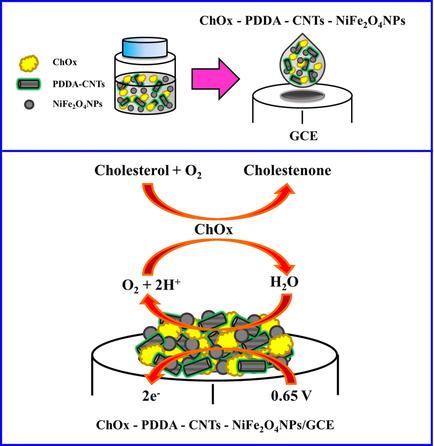当前位置:
X-MOL 学术
›
Electroanalysis
›
论文详情
Our official English website, www.x-mol.net, welcomes your feedback! (Note: you will need to create a separate account there.)
A Single Drop Fabrication of the Cholesterol Biosensor Based on Synthesized NiFe2 O4 NPs Dispersed on PDDA-CNTs
Electroanalysis ( IF 3 ) Pub Date : 2017-09-13 , DOI: 10.1002/elan.201700286 Chochanon Moonla 1 , Anchana Preechaworapun 2 , Tanin Tangkuaram 1
Electroanalysis ( IF 3 ) Pub Date : 2017-09-13 , DOI: 10.1002/elan.201700286 Chochanon Moonla 1 , Anchana Preechaworapun 2 , Tanin Tangkuaram 1
Affiliation

|
A cholesterol biosensor based on cholesterol oxidase-poly(diallyldimethylammonium chloride)-carbon nanotubes-nickel ferrite nanoparticles (ChOx-PDDA-CNTs-NiFe2O4NPs) solution is easily fabricated by using a single dropping step on a glassy carbon electrode (GCE) surface. This technique is an alternative way to reduce complexity, cost and time to produce the biosensor. The uniformly dispersed materials on the electrode surface enhance the catalytic reaction of cholesterol oxidase and electron transfer from the oxidation of hydrogen peroxide in the system. The nickel ferrite nanoparticles were synthesized by co-precipitation and calcination at various temperatures. These nanoparticles were then characterized using field emission scanning electron microscopy (FE-SEM), energy-dispersive X-ray spectroscopy (EDX), Fourier transform infrared spectroscopy (FTIR), cyclic voltammetry (CV) and X-ray diffraction (XRD). The synthesized material calcined at 700 °C was well defined and presented the octahedral metal stretching with cubic NiFe2O4NPs phase. In cyclic voltammetric study, the ChOx-PDDA-CNTs-NiFe2O4NPs/GCE showed 0.43 s−1 charge transfer rate constant (Ks), 7.79×10−6 cm2 s−1 diffusion coefficient value (D), 0.13 mm2 electroactive surface area (Ae) and 3.58×10−8 mol cm−2 surface concentration (γ ). This modified electrode exhibits stability in term of percent relative standard deviation (%RSD=0.62 %, n=10), reproducibility (%RSD=0.81, n=10), high sensitivity (25.76 nA per mg L−1 cm−2), linearity from 1 to 5,000 mg L−1 (R2=0.998) with a low detection limit (0.50 mg L−1). Its Michaelis-Menten constant (Km) was 0.14 mM with 0.92 μA maximum current (Imax) and demonstrated good selectivity without the effects of electroactive species such as ascorbic acid, glucose and uric acid. The cholesterol biosensor was successfully applied to determine cholesterol levels in human blood samples, showing promise due to its simplicity and availability.
中文翻译:

基于分散在 PDDA-CNTs 上的合成 NiFe2 O4 NPs 的胆固醇生物传感器的单滴制备
基于胆固醇氧化酶-聚(二烯丙基二甲基氯化铵)-碳纳米管-镍铁氧体纳米粒子(ChOx-PDDA-CNTs-NiFe2O4NPs)溶液的胆固醇生物传感器可以通过在玻璃碳电极(GCE)表面上使用单个滴下步骤轻松制造。该技术是降低生产生物传感器的复杂性、成本和时间的替代方法。电极表面均匀分散的材料增强了胆固醇氧化酶的催化反应和系统中过氧化氢氧化产生的电子转移。镍铁氧体纳米颗粒是通过在不同温度下共沉淀和煅烧合成的。然后使用场发射扫描电子显微镜 (FE-SEM)、能量色散 X 射线光谱 (EDX)、傅里叶变换红外光谱 (FTIR)、循环伏安法 (CV) 和 X 射线衍射 (XRD)。在 700 °C 煅烧的合成材料被明确定义并呈现出具有立方 NiFe2O4NPs 相的八面体金属拉伸。在循环伏安研究中,ChOx-PDDA-CNTs-NiFe2O4NPs/GCE 表现出 0.43 s-1 电荷转移速率常数 (Ks)、7.79×10-6 cm2 s-1 扩散系数值 (D)、0.13 mm2 电活性表面积 ( Ae) 和 3.58×10-8 mol cm-2 表面浓度 (γ )。这种改良电极在相对标准偏差百分比 (%RSD=0.62%, n=10)、重现性 (%RSD=0.81, n=10)、高灵敏度 (25.76 nA/mg L−1 cm−2) 方面表现出稳定性, 线性范围为 1 至 5,000 mg L-1 (R2=0.998),检测限低 (0.50 mg L-1)。其 Michaelis-Menten 常数 (Km) 为 0.14 mM,0. 92 μA 最大电流 (Imax) 并表现出良好的选择性,不受电活性物质(例如抗坏血酸、葡萄糖和尿酸)的影响。胆固醇生物传感器已成功应用于测定人体血液样本中的胆固醇水平,因其简单性和可用性而显示出前景。
更新日期:2017-09-13
中文翻译:

基于分散在 PDDA-CNTs 上的合成 NiFe2 O4 NPs 的胆固醇生物传感器的单滴制备
基于胆固醇氧化酶-聚(二烯丙基二甲基氯化铵)-碳纳米管-镍铁氧体纳米粒子(ChOx-PDDA-CNTs-NiFe2O4NPs)溶液的胆固醇生物传感器可以通过在玻璃碳电极(GCE)表面上使用单个滴下步骤轻松制造。该技术是降低生产生物传感器的复杂性、成本和时间的替代方法。电极表面均匀分散的材料增强了胆固醇氧化酶的催化反应和系统中过氧化氢氧化产生的电子转移。镍铁氧体纳米颗粒是通过在不同温度下共沉淀和煅烧合成的。然后使用场发射扫描电子显微镜 (FE-SEM)、能量色散 X 射线光谱 (EDX)、傅里叶变换红外光谱 (FTIR)、循环伏安法 (CV) 和 X 射线衍射 (XRD)。在 700 °C 煅烧的合成材料被明确定义并呈现出具有立方 NiFe2O4NPs 相的八面体金属拉伸。在循环伏安研究中,ChOx-PDDA-CNTs-NiFe2O4NPs/GCE 表现出 0.43 s-1 电荷转移速率常数 (Ks)、7.79×10-6 cm2 s-1 扩散系数值 (D)、0.13 mm2 电活性表面积 ( Ae) 和 3.58×10-8 mol cm-2 表面浓度 (γ )。这种改良电极在相对标准偏差百分比 (%RSD=0.62%, n=10)、重现性 (%RSD=0.81, n=10)、高灵敏度 (25.76 nA/mg L−1 cm−2) 方面表现出稳定性, 线性范围为 1 至 5,000 mg L-1 (R2=0.998),检测限低 (0.50 mg L-1)。其 Michaelis-Menten 常数 (Km) 为 0.14 mM,0. 92 μA 最大电流 (Imax) 并表现出良好的选择性,不受电活性物质(例如抗坏血酸、葡萄糖和尿酸)的影响。胆固醇生物传感器已成功应用于测定人体血液样本中的胆固醇水平,因其简单性和可用性而显示出前景。



























 京公网安备 11010802027423号
京公网安备 11010802027423号